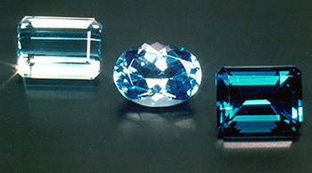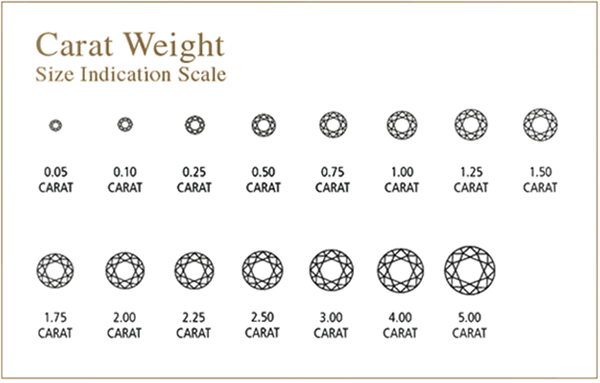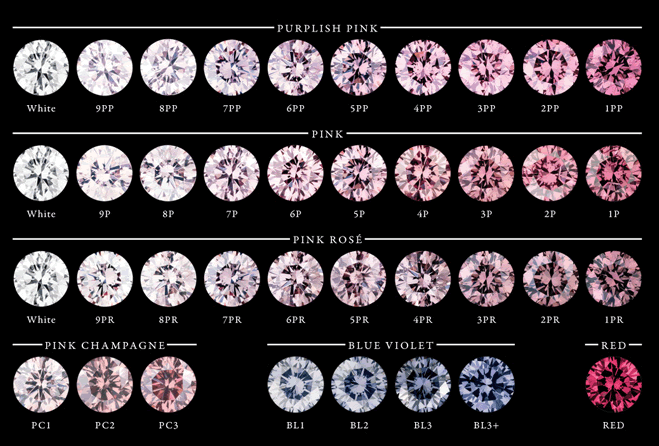Gemstones can be treated and enhanced for a more pleasing visual effect, using methods that have existed for centuries. Undetectable and permanent enhancements ensure that there are always beautiful gemstones in the market. If these treatments are stable, the stone’s value increases. Treatments that are less stable should be avoided. It is important that buyers are educated on the different types of treatments available, whether the treatment produces minute changes or dramatic change. One example of this is colourless topaz – irradiation and heating of colourless topaz permanently transforms it into blue topaz.

Three Colors of Irradiated Topaz, Brazil
(Photo by ICA/Bart Curren)
Treatment is usually performed by the cutter, or lapidary, who after obtaining a rough gem wishes to sell the most valuable gem possible. Since many treatments are performed in the countries which cut and mine the stones, disclosure of the treatments may not always happen. Sapphires and rubies, for example, are often heated before the rough stones are sold to the cutters.
Since details of treatments are not always given, a buyer must be informed. The price alters depending on the type of treatment and the type of stone itself. Some gemstones require enhancement to be sold at all. Citrine and tanzanite are naturally rare – only with a heating treatment is there enough supply to meet demand for these stones.
Some gemstones do not require enhancement by present technology at all: Garnets, peridot, iolite, spinel, all varieties of chrysoberyl, catseye tourmaline, malachite, hematite, and all feldspar including all varieties of moonstones. In the future this may change, as new technologies and methods of treating gemstones change every year.
Heating
Heating is the most common treatment, and can lighten, darken or clarify gems. Rarely, colour is changed completely. It is fair to assume the following are heated: rubies, sapphires, tanzanite, citrine, pink topaz, aquamarine, and blue and colourless zircon. Tourmaline and amethyst are occasionally heated to a lighter colour.
Irreversible and almost undetectable, heating often enhances the appearance of the gem and there is rarely a great price difference. Indeed, some gems are almost worthless without heating, such as tanzanite, citrine, pink topaz, blue and colourless zircon. Rubies and sapphires which have not been heated sometimes contain microscopic rutile needles or tiny gas bubbles in pockets of liquid, which are detectable by the right people. It is extremely rare that these unheated gems are of good colour – those that are will be sold at premium prices.
Oiling
Oiling is most commonly used on emeralds. They are stored as rough emeralds in oil, and oil is used as lubricant when they are cut, allowing the oil to penetrate any fissures on the surface and render them less visible. If there are no fractures on the surface, no oil penetrates the emerald and if the colour is consistent the stone will fetch a premium price. Oil may be leached out of the emerald if it is steamed clean or put into an ultrasonic. Since this can result in the fractures reappearing, the emerald can be re-oiled.
Low-quality rubies are oiled, and coloured oil is used to add colour and conceal fractures on other stones. This is uncommon among reputable jewellers, but something to avoid as the true colour is unclear.
Fractures are also often filled with synthetic resins and hardeners, a more permanent solution than oiling.
Irradiation
Irradiation is the process of exposing the gemstone to subatomic particles or radiation. It is sometimes followed by heating, which changes the colour. This is commonly done to blue topaz, rare and pale in nature but available at reasonable prices in different shades after irradiation. A natural blue topaz of fine colour would, of course, fetch a higher price without treatment.
Tourmaline is sold at the same price after irradiation, to darken pink stones into red ones, identical to the red tourmaline found naturally.
Irradiation and heating can create diamonds of intense greens, yellows, blues and browns. Ask the seller about treatments if you wish to purchase a fancy coloured diamond, particularly green, for they should be sold for less than natural diamonds of similar colour, cut, clarity grade and size.
Dyeing
The benefits and disadvantages of dyeing depends on the variety of stone. Black onyx would not exist without dyeing, nor would the more intense colours of pearl and agate. After dyeing, colours are more attractive, though they lack the edge that naturally coloured stones have. In short, it is fine to purchase a dyed gem, as long as you know that it has been treated and there is no deception.
Dyeing becomes less acceptable when it is done to disguise poor quality – this often happens to jade, lapis lazuli, turquoise and coral. Some can be tested – rub lapis lazuli with cotton and acetone, and you will see blue on the cotton if it has been dyed. Fine, if the seller has told you. Compare the price of the real thing to the dyed and make your own decision as an informed buyer. Beware a price that is ‘too good to be true’. Some materials are more difficult to test, such as coral and jade.
Surface diffusion
Surface diffusion is the infusion of chemicals onto a sapphire with heat. This improves its colour or creates asterism (where light reflects off the stone in a star shape). The colour can be removed, and must be removed if the stone is to be repolished.
Filling
Surface fractures or cavities can be filled with glass, plastic or other materials. Rubies are often filled. It takes close magnification to spot the differences in surface lustre that indicate a will to deceive the buyer. It is difficult to know what the price should be, due to the enhancement covering the true quality of the gem.
‘Yehuda filled diamonds’ entered the market within the last few decades, but again, is only acceptable when buyers are informed of the treatment. To begin with, diamonds with such cracks that are easily visible are of a poor quality. Filling covers this up, but it doesn’t change the quality of the stone and the filling can melt back out during any repairs if the jeweller wasn’t told about the enhancement. The price should reflect the true quality of the gemstone, even with its visual enhancements.
Lasering
Lasering is the drilling of minute holes into a diamond to provide access to an inclusion which can be bleached to improve a stone’s appearance. It is a rare practice, and easily visible under magnification. Slightly imperfect, and imperfect diamonds, are the types which are lasered, and their clarity grade, and price, should not change.





